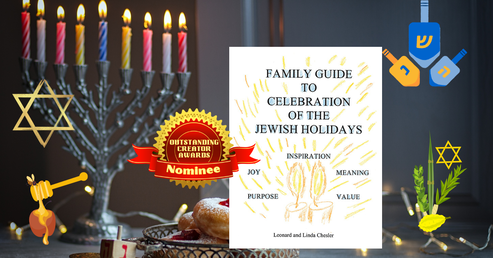|
Score 88/100 (8.8 out of 10)
Family Guide to Celebration of the Jewish Holidays is an intriguing dive into Jewish traditions as explored by Leonard and Linda Chesler, an excellent husband and wife team. The authors are clearly passionate about this topic and their hearts are definitely in it. Some of the depth they go into about these Jewish holidays are very impressive and interesting. Let's give readers a little background just to get a feel of the magnitude and significance of this book. Judaism is the grandfather of all Abrahamic religions. That's right, without Judaism there would be no Christianity or Islam including all of their variants and sects. Judaism, along with Christianity and Greco-Roman culture, forms the foundation of the western world, and much of eastern world as well! So, let's just say that Jewish culture and their traditions (including their holidays) are historically and culturally significant to the world as a whole. Again, just think about how deep these roots go. Just think about all the things that we do and the things we celebrate because of what originated in ancient Israel—Christmas, Easter, laws based on the Ten Commandments, even weekends! Heck, even vacation days could arguably have their roots in the Sabbath. Something very unique about this book is that despite discussing some unsavory events like slavery and the plagues in Egypt, Babylonian captivity, war in the Middle East (and throughout the world), the Spanish Inquisition, and the Holocaust, this book's tone remains positive and educational. In other words, it doesn't make the reader feel awful and uncomfortable about the terrible things that have gone on in the past. Instead, the book shows us how the Jewish people and their religion have persevered through numerous hardships and still came out on top—with their faith restored or strengthened, and with their culture in tact. That's really special, and infinitely admirable. Another thing that we loved about this book is that it is actually inviting, welcoming, and inclusive. Let's just be blunt: there's a perception of the Jewish people and their religion as being at least somewhat elitist. They are God's chosen and elect after all. What's actually a welcome surprise in this book is how the authors emphasize the fact that the Jewish people are meant as an example to the rest of the world of God's goodness, glory, and grace. Ultimately, they are supposed to be bringers of peace and prosperity to the rest of the world, a world that is hurting and suffering—sorely in need of God's mercy. This book covers such holidays as Rosh Hashanah (New Year), Yom Kippur (Day of Atonement), Sabbath, Passover, and Hanukkah. These are special days on the calendar that many of us are at least somewhat familiar with. However, did you know that there are other special days on the Jewish calendar such as Tu Bi-Shevat, Purim, and Shavuot? The authors went into great depth about the holidays we're both familiar with and not so familiar with. These holidays are loaded with history and cultural significance. There's a story behind each one. Like, not only do the authors go over the part of the Hannukah story we all hear: that the Israelites rebelled against the oppressive, sacrilegious Atiochus Epiphanes, you get to learn about each of the Maccabees and their motivations. You get to learn about what went on before and after the conflict, going all the way back to Alexander the Great's Macedonian empire and its incursion into ancient Israel. You get to learn about the significance of each candle of the menorah being lit from day to day, reflecting how the menorah remained lit far longer than expected—a miracle. So, why is this book just under a 9/10? Well, the main issue with this book isn't really the content or the writing, it's the formatting and the presentation. The content and the writing are solid. The problem is that this book really could've used a professional formatter. First of all, there are no indentations to be found. Every paragraph is its own block or wall of text. It just doesn't look refined or professional in that sense. Another thing is that, considering the subject matter, there ought to be some pictures. We know that might sound petty, but when you're educating people about traditions and cultures that may be foreign or new to them, it helps to show them what you're talking about. It's not just for fluff and padding, it actually adds a helpful, educational layer to a text like this. Think about an Encyclopedia Britannica. Remember how each page wasn't just one huge wall of text but that occasionally you'd get images showing what certain parts were talking about? There are loads of royalty-free, free-use images on Canva and Netgalley that could be used. All it would take is some tact in placing them and a caption for each. Now, that would be refined! With all that said, we loved this book for what it was: a work that clearly had a lot of heart and soul behind it, made by an incredible Jewish couple with years of experience in the faith/culture. They truly understand the importance and significance of sharing and propagating their practices and traditions. We cheer on and support these authors and the Jewish people as they continue to strive to be a light unto the world as Yahweh intended! Check this out on Amazon!
0 Comments
Leave a Reply. |
Archives
July 2024
Categories |

 RSS Feed
RSS Feed